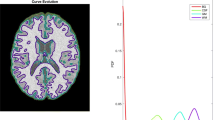Abstract
Many successful methods for biomedical image segmentation are based on supervised learning, where a segmentation algorithm is trained based on manually labeled training data. For supervised-learning algorithms to perform well, this training data has to be representative for the target data. In practice however, due to differences between scanners such representative training data is often not available.
We therefore present a segmentation algorithm in which labeled training data does not necessarily need to be representative for the target data, which allows for the use of training data from different studies than the target data. The algorithm assigns an importance weight to all training images, in such a way that the Kullback-Leibler divergence between the resulting distribution of the training data and the distribution of the target data is minimized.
In a set of experiments on MRI brain-tissue segmentation with training and target data from four substantially different studies our method improved mean classification errors with up to 25% compared to common supervised-learning approaches.
Access this chapter
Tax calculation will be finalised at checkout
Purchases are for personal use only
Preview
Unable to display preview. Download preview PDF.
Similar content being viewed by others
References
Pan, S., Yang, Q.: A survey on transfer learning. IEEE Transactions on Knowledge and Data Engineering 22(10), 1345–1359 (2010)
Sugiyama, M., Nakajima, S., Kashima, H., Von Buenau, P., Kawanabe, M.: Direct importance estimation with model selection and its application to covariate shift adaptation. In: Advances in Neural Information Processing Systems, vol. 20, pp. 1433–1440 (2008)
van Opbroek, A., Ikram, M.A., Vernooij, M.W., de Bruijne, M.: Supervised image segmentation across scanner protocols: A transfer learning approach. In: Wang, F., Shen, D., Yan, P., Suzuki, K. (eds.) MLMI 2012. LNCS, vol. 7588, pp. 160–167. Springer, Heidelberg (2012)
Chang, C., Lin, C.: LIBSVM: a library for support vector machines. ACM Transactions on Intelligent Systems and Technology (TIST) 2(3)
Ikram, M., van der Lugt, A., Niessen, W., Krestin, G., Koudstaal, P., Hofman, A., Breteler, M., Vernooij, M.: The Rotterdam Scan Study: design and update up to 2012. European Journal of Epidemiology 26(10), 811–824 (2011)
Worth, A.: The Internet Brain Segmentation Repository (IBSR)
Sled, J., Zijdenbos, A., Evans, A.: A nonparametric method for automatic correction of intensity nonuniformity in MRI data. IEEE Transactions on Medical Imaging 17(1), 87–97 (1998)
Silverman, B.: Density estimation for statistics and data analysis, vol. 26. Chapman & Hall/CRC (1986)
Ashburner, J., Friston, K.: Unified segmentation. Neuroimage 26(3), 839–851 (2005)
Artaechevarria, X., Munoz-Barrutia, A., Ortiz-de Solorzano, C.: Combination strategies in multi-atlas image segmentation: Application to brain MR data. IEEE Transactions on Medical Imaging 28(8), 1266–1277 (2009)
Author information
Authors and Affiliations
Editor information
Editors and Affiliations
Rights and permissions
Copyright information
© 2013 Springer International Publishing Switzerland
About this paper
Cite this paper
van Opbroek, A., Ikram, M.A., Vernooij, M.W., de Bruijne, M. (2013). A Transfer-Learning Approach to Image Segmentation Across Scanners by Maximizing Distribution Similarity. In: Wu, G., Zhang, D., Shen, D., Yan, P., Suzuki, K., Wang, F. (eds) Machine Learning in Medical Imaging. MLMI 2013. Lecture Notes in Computer Science, vol 8184. Springer, Cham. https://doi.org/10.1007/978-3-319-02267-3_7
Download citation
DOI: https://doi.org/10.1007/978-3-319-02267-3_7
Publisher Name: Springer, Cham
Print ISBN: 978-3-319-02266-6
Online ISBN: 978-3-319-02267-3
eBook Packages: Computer ScienceComputer Science (R0)




